Zhiqiang Xu
Finite Samples for Shallow Neural Networks
Mar 17, 2025Abstract:This paper investigates the ability of finite samples to identify two-layer irreducible shallow networks with various nonlinear activation functions, including rectified linear units (ReLU) and analytic functions such as the logistic sigmoid and hyperbolic tangent. An ``irreducible" network is one whose function cannot be represented by another network with fewer neurons. For ReLU activation functions, we first establish necessary and sufficient conditions for determining the irreducibility of a network. Subsequently, we prove a negative result: finite samples are insufficient for definitive identification of any irreducible ReLU shallow network. Nevertheless, we demonstrate that for a given irreducible network, one can construct a finite set of sampling points that can distinguish it from other network with the same neuron count. Conversely, for logistic sigmoid and hyperbolic tangent activation functions, we provide a positive result. We construct finite samples that enable the recovery of two-layer irreducible shallow analytic networks. To the best of our knowledge, this is the first study to investigate the exact identification of two-layer irreducible networks using finite sample function values. Our findings provide insights into the comparative performance of networks with different activation functions under limited sampling conditions.
MagicDistillation: Weak-to-Strong Video Distillation for Large-Scale Portrait Few-Step Synthesis
Mar 17, 2025



Abstract:Fine-tuning open-source large-scale VDMs for the portrait video synthesis task can result in significant improvements across multiple dimensions, such as visual quality and natural facial motion dynamics. Despite their advancements, how to achieve step distillation and reduce the substantial computational overhead of large-scale VDMs remains unexplored. To fill this gap, this paper proposes Weak-to-Strong Video Distillation (W2SVD) to mitigate both the issue of insufficient training memory and the problem of training collapse observed in vanilla DMD during the training process. Specifically, we first leverage LoRA to fine-tune the fake diffusion transformer (DiT) to address the out-of-memory issue. Then, we employ the W2S distribution matching to adjust the real DiT's parameter, subtly shifting it toward the fake DiT's parameter. This adjustment is achieved by utilizing the weak weight of the low-rank branch, effectively alleviate the conundrum where the video synthesized by the few-step generator deviates from the real data distribution, leading to inaccuracies in the KL divergence approximation. Additionally, we minimize the distance between the fake data distribution and the ground truth distribution to further enhance the visual quality of the synthesized videos. As experimentally demonstrated on HunyuanVideo, W2SVD surpasses the standard Euler, LCM, DMD and even the 28-step standard sampling in FID/FVD and VBench in 1/4-step video synthesis. The project page is in https://w2svd.github.io/W2SVD/.
Pastiche Novel Generation Creating: Fan Fiction You Love in Your Favorite Author's Style
Feb 21, 2025Abstract:Great novels create immersive worlds with rich character arcs, well-structured plots, and nuanced writing styles. However, current novel generation methods often rely on brief, simplistic story outlines and generate details using plain, generic language. To bridge this gap, we introduce the task of Pastiche Novel Generation, which requires the generated novels to imitate the distinctive features of the original work, including understanding character profiles, predicting plausible plot developments, and writing concrete details using vivid, expressive language. To achieve this, we propose WriterAgent, a novel generation system designed to master the core aspects of literary pastiche. WriterAgent is trained through a curriculum learning paradigm, progressing from low-level stylistic mastery to high-level narrative coherence. Its key tasks include language style learning, character modeling, plot planning, and stylish writing, ensuring comprehensive narrative control. To support this, WriterAgent leverages the WriterLoRA framework, an extension of LoRA with hierarchical and cumulative task-specific modules, each specializing in a different narrative aspect. We evaluate WriterAgent on multilingual classics like Harry Potter and Dream of the Red Chamber, demonstrating its superiority over baselines in capturing the target author's settings, character dynamics, and writing style to produce coherent, faithful narratives.
FedMHO: Heterogeneous One-Shot Federated Learning Towards Resource-Constrained Edge Devices
Feb 12, 2025



Abstract:Federated Learning (FL) is increasingly adopted in edge computing scenarios, where a large number of heterogeneous clients operate under constrained or sufficient resources. The iterative training process in conventional FL introduces significant computation and communication overhead, which is unfriendly for resource-constrained edge devices. One-shot FL has emerged as a promising approach to mitigate communication overhead, and model-heterogeneous FL solves the problem of diverse computing resources across clients. However, existing methods face challenges in effectively managing model-heterogeneous one-shot FL, often leading to unsatisfactory global model performance or reliance on auxiliary datasets. To address these challenges, we propose a novel FL framework named FedMHO, which leverages deep classification models on resource-sufficient clients and lightweight generative models on resource-constrained devices. On the server side, FedMHO involves a two-stage process that includes data generation and knowledge fusion. Furthermore, we introduce FedMHO-MD and FedMHO-SD to mitigate the knowledge-forgetting problem during the knowledge fusion stage, and an unsupervised data optimization solution to improve the quality of synthetic samples. Comprehensive experiments demonstrate the effectiveness of our methods, as they outperform state-of-the-art baselines in various experimental setups.
Zigzag Diffusion Sampling: Diffusion Models Can Self-Improve via Self-Reflection
Dec 17, 2024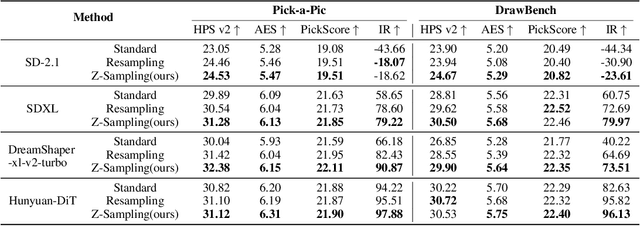
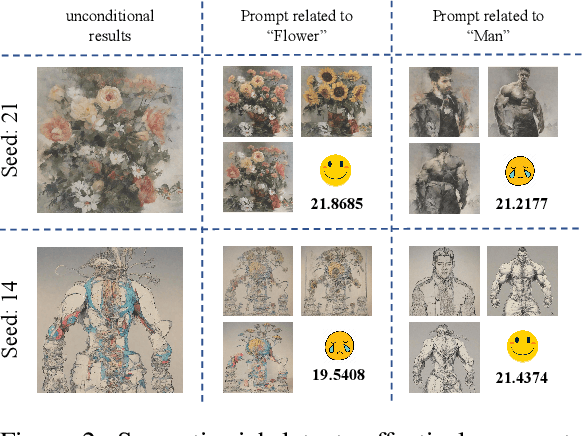

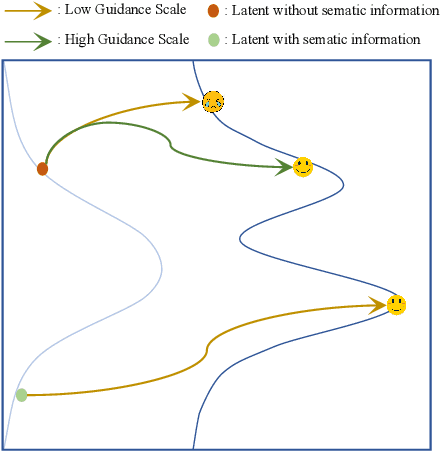
Abstract:Diffusion models, the most popular generative paradigm so far, can inject conditional information into the generation path to guide the latent towards desired directions. However, existing text-to-image diffusion models often fail to maintain high image quality and high prompt-image alignment for those challenging prompts. To mitigate this issue and enhance existing pretrained diffusion models, we mainly made three contributions in this paper. First, we propose diffusion self-reflection that alternately performs denoising and inversion and demonstrate that such diffusion self-reflection can leverage the guidance gap between denoising and inversion to capture prompt-related semantic information with theoretical and empirical evidence. Second, motivated by theoretical analysis, we derive Zigzag Diffusion Sampling (Z-Sampling), a novel self-reflection-based diffusion sampling method that leverages the guidance gap between denosing and inversion to accumulate semantic information step by step along the sampling path, leading to improved sampling results. Moreover, as a plug-and-play method, Z-Sampling can be generally applied to various diffusion models (e.g., accelerated ones and Transformer-based ones) with very limited coding and computational costs. Third, our extensive experiments demonstrate that Z-Sampling can generally and significantly enhance generation quality across various benchmark datasets, diffusion models, and performance evaluation metrics. For example, DreamShaper with Z-Sampling can self-improve with the HPSv2 winning rate up to 94% over the original results. Moreover, Z-Sampling can further enhance existing diffusion models combined with other orthogonal methods, including Diffusion-DPO.
A Simple and Efficient Baseline for Zero-Shot Generative Classification
Dec 17, 2024



Abstract:Large diffusion models have become mainstream generative models in both academic studies and industrial AIGC applications. Recently, a number of works further explored how to employ the power of large diffusion models as zero-shot classifiers. While recent zero-shot diffusion-based classifiers have made performance advancement on benchmark datasets, they still suffered badly from extremely slow classification speed (e.g., ~1000 seconds per classifying single image on ImageNet). The extremely slow classification speed strongly prohibits existing zero-shot diffusion-based classifiers from practical applications. In this paper, we propose an embarrassingly simple and efficient zero-shot Gaussian Diffusion Classifiers (GDC) via pretrained text-to-image diffusion models and DINOv2. The proposed GDC can not only significantly surpass previous zero-shot diffusion-based classifiers by over 10 points (61.40% - 71.44%) on ImageNet, but also accelerate more than 30000 times (1000 - 0.03 seconds) classifying a single image on ImageNet. Additionally, it provides probability interpretation of the results. Our extensive experiments further demonstrate that GDC can achieve highly competitive zero-shot classification performance over various datasets and can promisingly self-improve with stronger diffusion models. To the best of our knowledge, the proposed GDC is the first zero-shot diffusionbased classifier that exhibits both competitive accuracy and practical efficiency.
Exploring the Generalization Capabilities of AID-based Bi-level Optimization
Nov 25, 2024Abstract:Bi-level optimization has achieved considerable success in contemporary machine learning applications, especially for given proper hyperparameters. However, due to the two-level optimization structure, commonly, researchers focus on two types of bi-level optimization methods: approximate implicit differentiation (AID)-based and iterative differentiation (ITD)-based approaches. ITD-based methods can be readily transformed into single-level optimization problems, facilitating the study of their generalization capabilities. In contrast, AID-based methods cannot be easily transformed similarly but must stay in the two-level structure, leaving their generalization properties enigmatic. In this paper, although the outer-level function is nonconvex, we ascertain the uniform stability of AID-based methods, which achieves similar results to a single-level nonconvex problem. We conduct a convergence analysis for a carefully chosen step size to maintain stability. Combining the convergence and stability results, we give the generalization ability of AID-based bi-level optimization methods. Furthermore, we carry out an ablation study of the parameters and assess the performance of these methods on real-world tasks. Our experimental results corroborate the theoretical findings, demonstrating the effectiveness and potential applications of these methods.
Bag of Design Choices for Inference of High-Resolution Masked Generative Transformer
Nov 16, 2024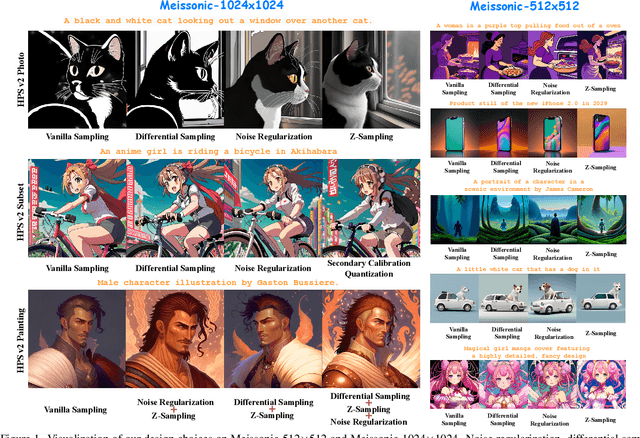
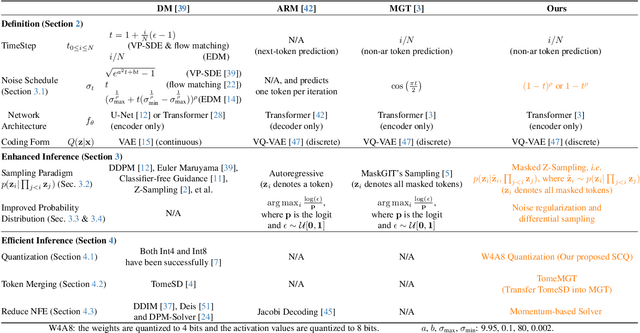
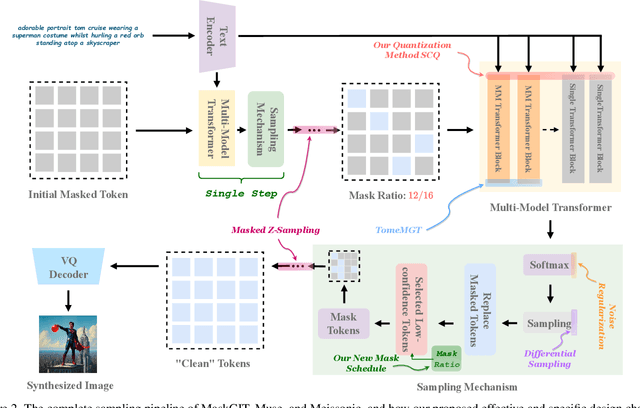
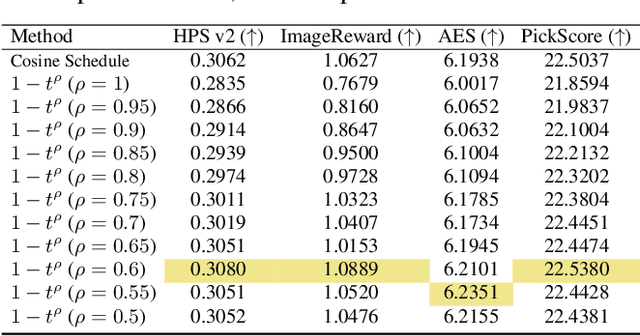
Abstract:Text-to-image diffusion models (DMs) develop at an unprecedented pace, supported by thorough theoretical exploration and empirical analysis. Unfortunately, the discrepancy between DMs and autoregressive models (ARMs) complicates the path toward achieving the goal of unified vision and language generation. Recently, the masked generative Transformer (MGT) serves as a promising intermediary between DM and ARM by predicting randomly masked image tokens (i.e., masked image modeling), combining the efficiency of DM with the discrete token nature of ARM. However, we find that the comprehensive analyses regarding the inference for MGT are virtually non-existent, and thus we aim to present positive design choices to fill this gap. We modify and re-design a set of DM-based inference techniques for MGT and further elucidate their performance on MGT. We also discuss the approach to correcting token's distribution to enhance inference. Extensive experiments and empirical analyses lead to concrete and effective design choices, and these design choices can be merged to achieve further performance gains. For instance, in terms of enhanced inference, we achieve winning rates of approximately 70% compared to vanilla sampling on HPS v2 with the recent SOTA MGT Meissonic. Our contributions have the potential to further enhance the capabilities and future development of MGTs.
Golden Noise for Diffusion Models: A Learning Framework
Nov 14, 2024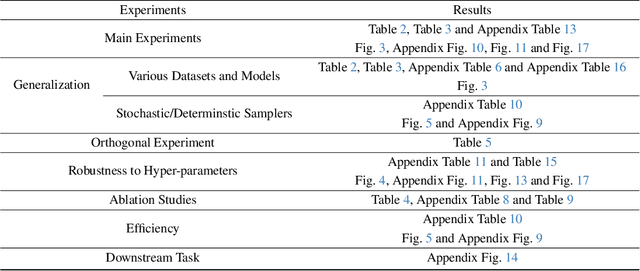

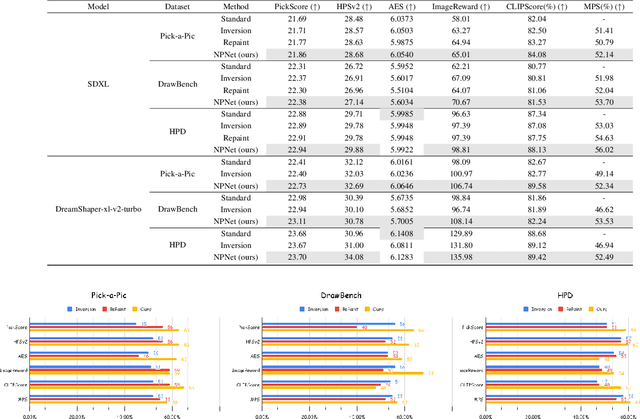

Abstract:Text-to-image diffusion model is a popular paradigm that synthesizes personalized images by providing a text prompt and a random Gaussian noise. While people observe that some noises are ``golden noises'' that can achieve better text-image alignment and higher human preference than others, we still lack a machine learning framework to obtain those golden noises. To learn golden noises for diffusion sampling, we mainly make three contributions in this paper. First, we identify a new concept termed the \textit{noise prompt}, which aims at turning a random Gaussian noise into a golden noise by adding a small desirable perturbation derived from the text prompt. Following the concept, we first formulate the \textit{noise prompt learning} framework that systematically learns ``prompted'' golden noise associated with a text prompt for diffusion models. Second, we design a noise prompt data collection pipeline and collect a large-scale \textit{noise prompt dataset}~(NPD) that contains 100k pairs of random noises and golden noises with the associated text prompts. With the prepared NPD as the training dataset, we trained a small \textit{noise prompt network}~(NPNet) that can directly learn to transform a random noise into a golden noise. The learned golden noise perturbation can be considered as a kind of prompt for noise, as it is rich in semantic information and tailored to the given text prompt. Third, our extensive experiments demonstrate the impressive effectiveness and generalization of NPNet on improving the quality of synthesized images across various diffusion models, including SDXL, DreamShaper-xl-v2-turbo, and Hunyuan-DiT. Moreover, NPNet is a small and efficient controller that acts as a plug-and-play module with very limited additional inference and computational costs, as it just provides a golden noise instead of a random noise without accessing the original pipeline.
Online Parallel Multi-Task Relationship Learning via Alternating Direction Method of Multipliers
Nov 09, 2024
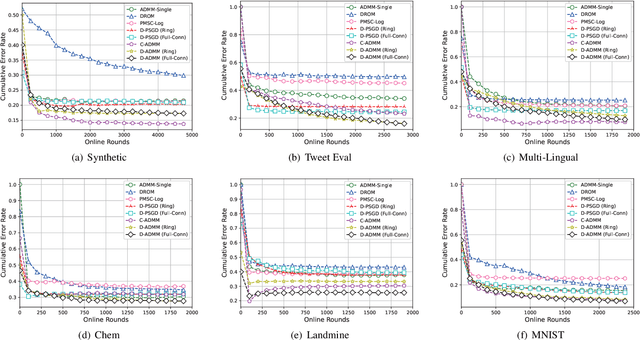


Abstract:Online multi-task learning (OMTL) enhances streaming data processing by leveraging the inherent relations among multiple tasks. It can be described as an optimization problem in which a single loss function is defined for multiple tasks. Existing gradient-descent-based methods for this problem might suffer from gradient vanishing and poor conditioning issues. Furthermore, the centralized setting hinders their application to online parallel optimization, which is vital to big data analytics. Therefore, this study proposes a novel OMTL framework based on the alternating direction multiplier method (ADMM), a recent breakthrough in optimization suitable for the distributed computing environment because of its decomposable and easy-to-implement nature. The relations among multiple tasks are modeled dynamically to fit the constant changes in an online scenario. In a classical distributed computing architecture with a central server, the proposed OMTL algorithm with the ADMM optimizer outperforms SGD-based approaches in terms of accuracy and efficiency. Because the central server might become a bottleneck when the data scale grows, we further tailor the algorithm to a decentralized setting, so that each node can work by only exchanging information with local neighbors. Experimental results on a synthetic and several real-world datasets demonstrate the efficiency of our methods.
 Add to Chrome
Add to Chrome Add to Firefox
Add to Firefox Add to Edge
Add to Edge